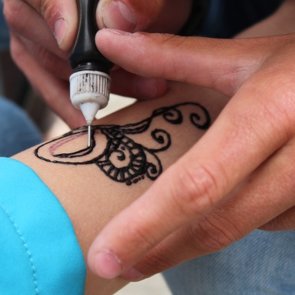6 Things You Need to Know About Henna Tattoos
 Mehndi, also known as henna tattoo, is a form of body art that dates back to ancient India. Originally practiced during Hindu festivals and weddings, mehndi designs became popular and fashionable in the West in the late 1990s, largely thanks to Indian cinema and the entertainment industry in general. Here are six things you need to know about henna tattoos before getting one.
Mehndi, also known as henna tattoo, is a form of body art that dates back to ancient India. Originally practiced during Hindu festivals and weddings, mehndi designs became popular and fashionable in the West in the late 1990s, largely thanks to Indian cinema and the entertainment industry in general. Here are six things you need to know about henna tattoos before getting one.The dye is prepared from the same plant as henna hair dye. The mehndi dye is prepared from the plant Lawsonia inermis, also known as the henna tree. When applied to the skin, it produces a rich red-brown stain, which gradually darkens because of oxidation. Traditional mehndi designs are always brown, but today, henna is sometimes mixed with other ingredients, both plant-based and synthetic (for example, p-Phenylenediamine), to give it other colors such as black, red, and gold.
Red (natural) henna is safer than other types of paste. Natural henna paste contains only henna powder, water, and sometimes additional natural ingredients such as lemon juice or essential oils. It is unlikely to cause allergic reactions, especially if your skin is not prone to sensitivity. If you have sensitive skin, avoid henna paste with lemon juice and/or essential oils, because these ingredients may cause mild allergic reactions.
Pre-mixed commercial pastes for henna body art, however, are another thing. Ingredients added to darken or alter stain color can cause allergic reactions (redness, itching, blistering) or inflammation. This doesn’t mean that all types of henna paste that are not reddish brown are dangerous, but you should definitely be more careful with them. Keep in mind that black henna does not exist! Any black henna paste contains synthetic dyes, there are no exceptions.
Henna designs don’t take long to apply. Unlike “real” tattoos, henna designs are applied relatively quickly, especially by an experienced henna artist. Depending on the size and intricacy of design, it can take 5 to 20 minutes. Of course, intricate henna designs applied during Hindu weddings can take hours to apply, but simple mehndi tattoos don’t take long. Additionally, you’ll need to wait for about six hours after the dye is applied and then rub the dried paste off to reveal the design.
Henna tattoos aren’t actually tattoos. Although referred to as “henna tattoos”, mehndi designs are temporary. They usually last between one to three weeks, gradually fading due to skin exfoliation. The lifespan of a henna tattoo depends on the type and quality of henna paste, as well as where exactly it was applied on your body (the thicker the skin, the longer it will last). It can be reduced by some factors such as chlorinated pool water.
You can make henna designs last longer. There are ways to extend the lifespan of a henna tattoo, although not by much. First of all, leave your henna design untouched for several hours after it was applied. After that, avoid washing the area frequently, and when you absolutely need to wash it, try not to rub the skin or use soap. Regularly moisturizing your skin with natural oils, such as coconut or olive, will also make your henna tattoo last longer.
You can remove a henna tattoo. Once the dye begin to fade, you may want to remove the design completely. There are some ways to get rid of a henna tattoo, although we can’t guarantee that they are 100% effective because much depends on the type of henna paste and the peculiarities of your skin. You can try to remove a henna design by scrubbing your skin with an exfoliating scrub (either store-bought or homemade) or using makeup remover.
Unfortunately, there is no way to quickly remove a fresh henna tattoo. If you have an allergic reaction to henna dye, don’t try to remove it yourself! Instead, consult a dermatologist as soon as possible.